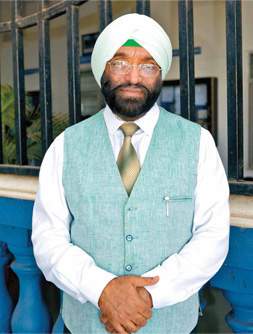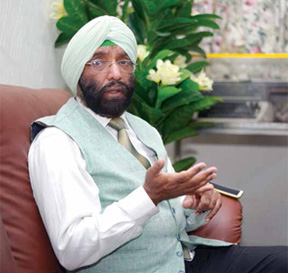One of the most reliable barometers of a country’s development is comparing the number of its exports vis-à-vis its imports. India is one of the top exporting nations in the world, and thanks to academicians like Professor H. P. Singh, Senior Faculty and Programme Incharge, National Institute for Entrepreneurship and Small Business Development (NIESBUD), Ministry of Skill Development & Entrepreneurship, Government of India, more and more youngsters are getting attracted to the fascinating field of import-export. Corporate Citizen chats with Professor H.P. Singh, at an academic event held in Pune about the intricacies of the field, its tremendous potential, and why anyone can become an exporter with minimal capital

I passed my M.Com in 1980 from Delhi University. After that, I opted for teaching at the university as well as research. I did consumer research and research marketing. I started my own import -export business while also working with foreign buyers and sellers. I was their buying agent in India. Later on, I shifted full time to teaching, as several of my friends too were in the profession. I started my own institute in the name of the Export Management & Services Institute. I am a Director there. Since then, I used to visit The National Institute for Small Business Development (NIESBUD). I used to conduct the complete programme at the institute with my faculty. One day the Director General asked me to join NIESBUD. I thought it was a good offer and I joined. The mandate of NIESBUD is entrepreneurship. My area of expertise is entrepreneurship as well as international entrepreneurship. Under my control, NIESBUD has conducted 112 programmes on exports. The 113th programme is already announced. The mandate of NIESBUD is not to give placements, but to help students start their own business. In between, I have attended an international business programme from IIM Ahmedabad.
We help students start their own business, we give them practical knowledge and expertise that enables them to become entrepreneurs. Several of my students have already started their business. We don’t just teach Indian students, but international ones as well. Since 1983, we have been able to impart education to students from over 140 countries. Even now, 78 participants from 32 countries are staying in our hostel. Most of them come from African countries, CIS, LAC and Asian countries. Some come from Eastern Europe as well. They learn from us and implement the learning back in their own countries.
Our balance of payment differs from country to country. We have a surplus with so many countries and deficit with some other countries. Overall, we are in a deficit. But there is a reason for that. Our main import is crude oil. If we remove crude oil from the equation, then we are in a surplus. Our exports last year were $307 billion. In 1985, we used to beg from the World Bank to help us clear our import bill. But in 2008, we gave a loan to the World Bank of $100 billion.
If you look back at the history of exports, around 1920, the contribution of India was 70% of the total foreign trade. Now the contribution is only 2%. This is because several other countries have started exporting too. There is tremendous competition. Ten per cent is not a small amount in this scenario. India is able to export over 12,000 items. This is not a small achievement.
"IN TODAY’S DAY AND AGE, IF YOU ARE INTO IMPORT-EXPORT, YOU SHOULD KNOW ABOUT E-COMMERCE AND DIGITAL MARKETING. WE CAN BRING THE DOLLAR RATE FROM Rs.70 TO Rs.24, IF ONLY MORE YOUTH OPT FOR THE IMPORT-EXPORT BUSINESS. ONLY 10% OF INDIANS CURRENTLY ARE INTO THIS BUSINESS. SOUTH KOREA, FOR EXAMPLE, HAS 94% OF PEOPLE IN THE BUSINESS"
E-commerce is essentially a retail business. But we are interacting with online to connect products to consumers. We are growing in import-export thanks to e-commerce. In today’s day and age, if you are into import-export, you should know about e-commerce and digital marketing. We can bring the Dollar rate from Rs.70 to Rs.24, if only more youth opt for the import-export business. Only 10% Indians currently are into this business. South Korea, for example, has 94% of people in the business.
It is a myth that the import-export business requires a lot of capital. I am personally working with small business development, and I can train people who have 2-3 lakhs, that too not in hand, but merely the ability to attain a loan of this amount, you can start your export business. We are imparting all this knowledge of at which stage you need how much money. We have to see our SWOT. If we have a little money, we should go for small orders. In the export business, you should always start small. This is a complex business, profits are more, but so are the losses.
The National Institute for Entrepreneurship and Small Business Development is a premier organization of the Ministry of Skill Development and Entrepreneurship, engaged in training, consultancy, research, etc. in order to promote entrepreneurship and Skill Development. The major activities of the Institute include Training of Trainers, Management Development Programmes, Entrepreneurship- cum-Skill Development Programmes, Entrepreneurship Development Programmes and Cluster Intervention. NIESBUD has provided training to 11,46,209 persons as of March 31, 2018, through 44,035 different training programmes since inception. This includes 4,384 international participants hailing from more than 141 countries throughout the globe.
(Source: https://niesbud.nic.in)
It’s certainly not hard. It depends on the training. In my institute, there are students doing a domestic business of Rs.5 crores. They want to go for exports. They don’t need theory knowledge. They need practical knowledge. We help them starting from how to register a firm for import-export with the government of India, and then step by step we give them details on how to start exporting. After a six full days programme, they are all set to go. Several of my students have opened offices in foreign countries as well. It takes a little time, but it isn’t hard.
Certainly. The premier institute in the field is the Indian Institute of Foreign Trade (IIFT). They have certificate programmes as well as two-year programmes. These courses, however, are more oriented for students wanting jobs. They don't start on their own immediately. We, on the other hand, give all the tools to start their own business.
China and India both are members of the World Trade Organization (WTO). We cannot avoid them, as India has a lot of people who prefer cheaper goods from China. Also, we are making China dependent on India for trade, which keeps the relation between the countries stable and refuses the chances of war. Secondly, we have Make in India scheme. As a WTO member, we cannot say don’t import from China. But what we can do is say that don’t buy the finished goods from China. Buy the raw materials from China and assemble in India but make the goods here. This will create employment in India as well, and bring down costs in the process. China works with large quantities for trade. India’s specialty is small quantities. Online retail, for example, prefers small quantities.
India has Special Economic Zones (SEZ) to boost exports. State-of-the-art ports are there. The complete setup is there. The government has given all the facilities. The only problem is that there is a lack of information and people are not aware of these facilities. I am surprised to know that even some exporters are not aware the role of ECGC and the Indian Institute of Packaging for the development of export.
We are quite strong in garment exports. We made the Bangladesh garment export industry. Earlier there was a quota, from 1975-2004. There was a restriction that we can’t export more than a certain number of garments to the US. Bangladesh was an underdeveloped country. So our Indian exporters moved there, set up plants, and the fabric went from India to Bangladesh, it was finished there, and it got a made in Bangladesh tag. In 2005, the quota got over. We developed Bangladesh, but now they are our competitor. In garments, India has the edge on quality and design
It is true that countries like the UK and US have become protectionist. However, most Indians think that exports mean exporting only to the US or UK. We are exporting to over two hundred countries. We are part of the SAARC trade bloc. Within the SAARC countries, India is rising in trade. Our trade with the SAARC bloc is $17 billion. This is not a small amount. Our Indian women have reduced wearing cotton sarees, due to a change in fashion. But Sri Lanka is a big market for these sarees. Why don’t we export sarees to Sri Lanka? Why are we always thinking of the US and other western countries? We are not choosing the right product for the right countries. Information is the hub of trade. We must have information about everything. If I ask people what is Suriname, they don’t know. Suriname is a country having 33% of Indians, but people don’t know this fact. This is a great market as Indians there will have needs for Indian products. They even speak Hindi or Bhojpuri there.
"MOST INDIANS THINK THAT EXPORTS MEAN EXPORTING ONLY TO THE US OR UK. WE ARE EXPORTING TO OVER TWO HUNDRED COUNTRIES. WE ARE PART OF THE SAARC TRADE BLOC. WITHIN THE SAARC COUNTRIES, INDIA IS RISING IN TRADE"

GST is a terror only for those who are not paying taxes. Earlier also, India was not charging VAT / GST for exports. We pay GST to our suppliers, and that money is refundable to exporters. It doesn’t matter what the GST is, because we get refunds.
There are challenges historically when it came to women participation in the field, but lately, those challenges have been addressed. There are good hotels around the world, there are adequate safety measures taken at ports/docks and in the countries so women can certainly feel comfortable in this industry. Women are doing business and the Indian government is giving them all the support. In most government schemes, women are the preference. Even getting a loan is easier for women now. They get lower interest rates. The mindset does pose as a deterrent for women to work, but even that is changing in recent times. Take for example Jyoti Naik of Lijjat Papad. She started the business with Rs.80 only, and now the turnover is Rs.600 crore with Rs.30 crore as exports. The other example is Nidhi Yadav of Indore, Computer Science graduate, now in ready to wear garments, started a business in 2014 with Rs.3.50 lakhs in a rented building, now turnover touching 75 Crores.
The first thing that is required is a winning mindset. Once you have a mindset, then you should get the requisite information. Find a strong product, do your research about the right market, get your permissions and plunge in.
We need to find the right mix of expertise, strengths, suppliers, and markets. It all depends on the right mix. Everyone needs to have some basic knowledge of economics and different cultures. For example, India is the only country which exports human hair. We export to African countries where there is a huge demand for this product amongst women.
I feel everyone should have a work-life balance. Work hard, and enjoy life as well. Especially in the import-export field, you get the opportunity to travel the world, eat at good hotels and enjoy with your family while you work.
BY NEERAJ VARTY